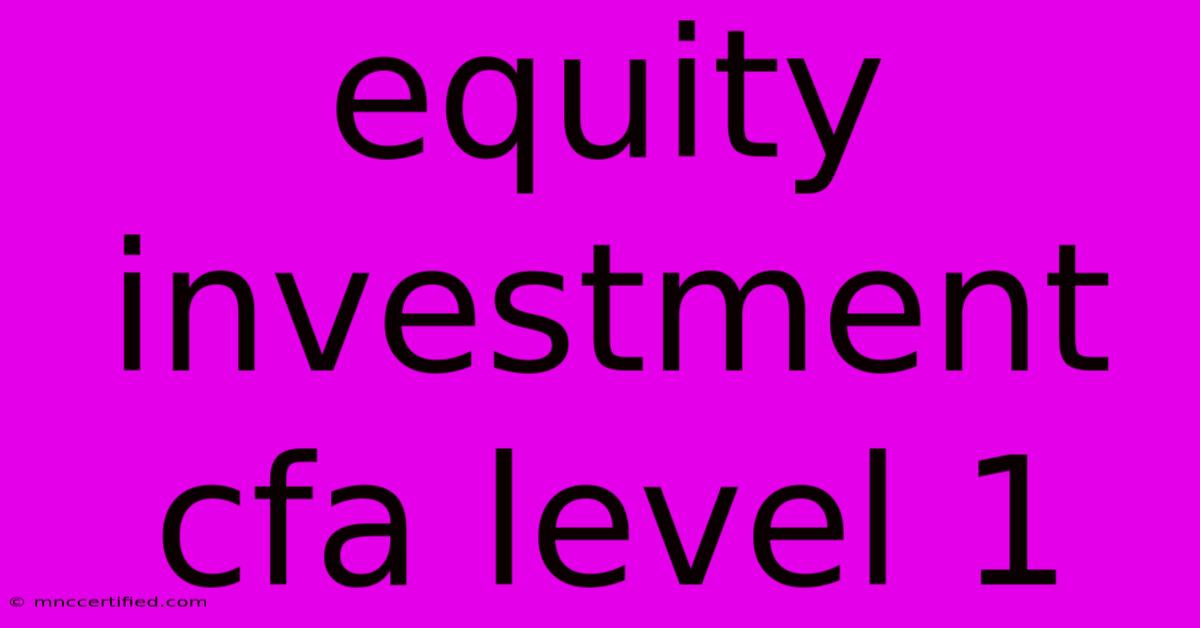Equity Investment Cfa Level 1

Table of Contents
Equity Investment: A Comprehensive Guide for CFA Level 1
The CFA Level 1 exam covers a broad range of topics in equity investment, demanding a thorough understanding of valuation, analysis, and portfolio management strategies. This comprehensive guide breaks down the key concepts you need to master for success.
Understanding Equity Investments
Equity investments represent ownership stakes in a company. They offer potential for high returns but also carry significant risk. Understanding the different types of equity is crucial:
- Common Stock: This represents the most basic form of ownership, carrying voting rights and residual claims on assets and earnings. Understanding the rights of common stockholders is paramount.
- Preferred Stock: This offers a hybrid of debt and equity characteristics. Preferred stockholders typically receive a fixed dividend payment before common stockholders, but often have limited or no voting rights. Knowing the differences in dividend payouts and liquidation preferences is key.
- Growth Stocks: These companies reinvest earnings to fuel future growth, often at the expense of current dividends. Analyzing their growth potential is critical for valuation.
- Value Stocks: These companies are perceived as undervalued by the market, offering potential for appreciation. Understanding intrinsic value and market inefficiencies is key to identifying them.
Equity Valuation: Key Methods for CFA Level 1
Accurate valuation is the cornerstone of successful equity investment. The CFA Level 1 curriculum emphasizes several key methods:
1. Discounted Cash Flow (DCF) Analysis
This intrinsic valuation method estimates a company's value by discounting its future cash flows back to their present value. Mastering the process of forecasting free cash flows, selecting an appropriate discount rate (WACC), and understanding the limitations of this model is crucial. Key considerations include terminal value calculations and sensitivity analysis.
2. Relative Valuation
This method compares a company's valuation metrics (e.g., P/E ratio, Price-to-Book ratio) to those of its peers or industry averages. Understanding the strengths and weaknesses of different multiples and how to adjust them for differences in accounting practices is vital. Remember to focus on appropriate benchmarks and the limitations of using ratios in isolation.
3. Asset-Based Valuation
This approach values a company based on the net asset value of its assets, often used for companies with substantial tangible assets. Understanding how to adjust book values for fair market values is crucial. This method is particularly relevant for companies undergoing liquidation or restructuring.
Equity Risk and Return
Understanding the relationship between risk and return is fundamental.
Risk Measures
- Standard Deviation: Measures the volatility of returns.
- Beta: Measures the systematic risk of a security relative to the market. Understanding the Capital Asset Pricing Model (CAPM) and its use in determining the required rate of return is essential.
- Sharpe Ratio: Measures risk-adjusted return.
Return Measures
- Arithmetic Mean: Simple average return.
- Geometric Mean: Compound average return, reflecting the effect of compounding.
Portfolio Management Strategies
CFA Level 1 also covers various portfolio management strategies for equity investments.
- Passive Management: This involves tracking a specific index, minimizing costs and aiming for market-matching returns. Understanding index funds and ETFs is essential.
- Active Management: This aims to outperform the market by selecting specific securities based on fundamental or technical analysis. Understanding various active management styles, such as value investing and growth investing, is important.
- Modern Portfolio Theory (MPT): This emphasizes diversification to minimize risk while maximizing returns. Understanding efficient frontiers and optimal portfolio construction is key.
Preparing for the CFA Level 1 Exam
Success on the CFA Level 1 exam requires diligent preparation. Consistent study, practice questions, and mock exams are crucial. Focus on understanding the underlying concepts, not just memorizing formulas. Utilizing official CFA Institute materials and reputable study providers can significantly enhance your chances of success.
Conclusion
Mastering equity investment for the CFA Level 1 exam requires a comprehensive understanding of valuation techniques, risk and return measures, and portfolio management strategies. By focusing on the key concepts outlined above and dedicating sufficient time to study, you can significantly improve your chances of achieving a passing score. Remember to consult official CFA Institute resources for the most up-to-date curriculum information.

Thank you for visiting our website wich cover about Equity Investment Cfa Level 1. We hope the information provided has been useful to you. Feel free to contact us if you have any questions or need further assistance. See you next time and dont miss to bookmark.
Featured Posts
-
Gary Barlow Irish Tour Includes Killarney
Nov 29, 2024
-
Stephen Mulhern Health Scare
Nov 29, 2024
-
East Bay Investment Solutions
Nov 29, 2024
-
Chiefs Add Humphries Pacheco
Nov 29, 2024
-
Nice Manager Ill After Strasbourg Game
Nov 29, 2024